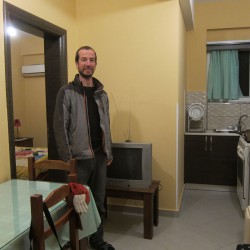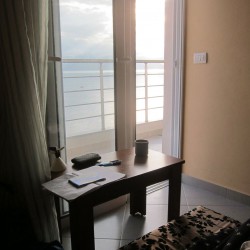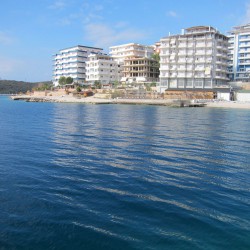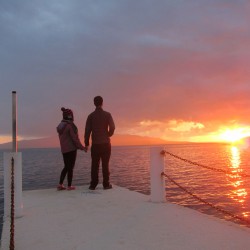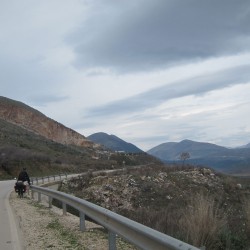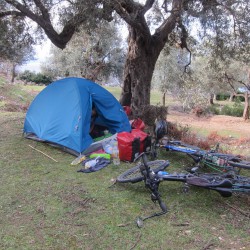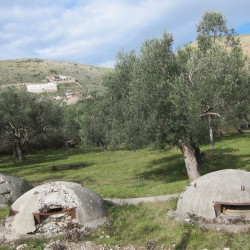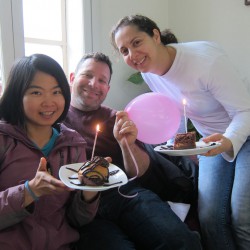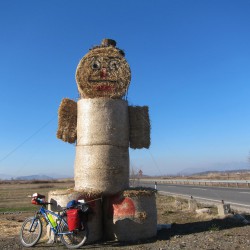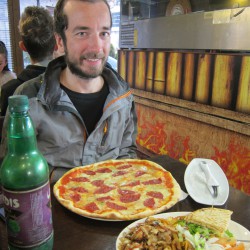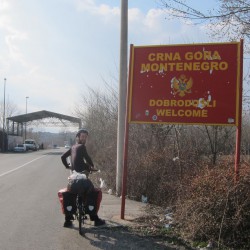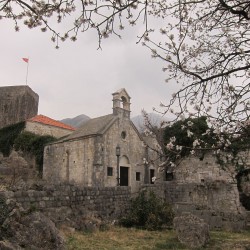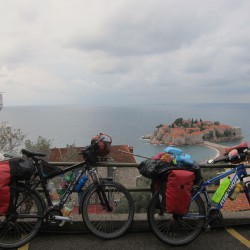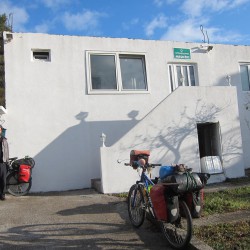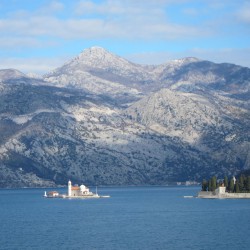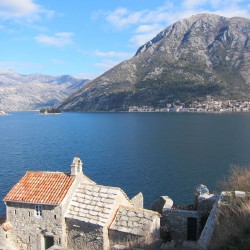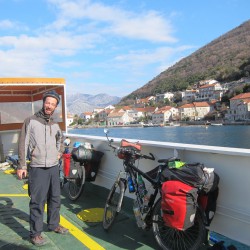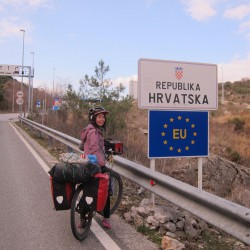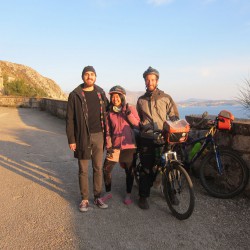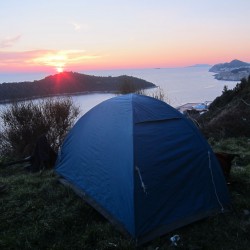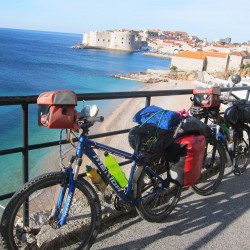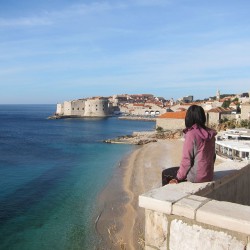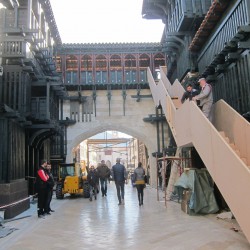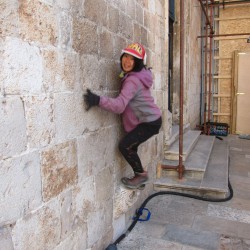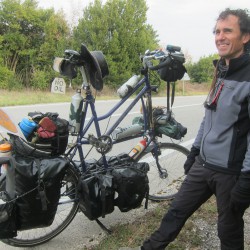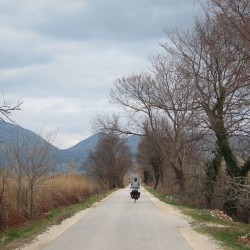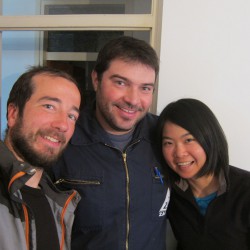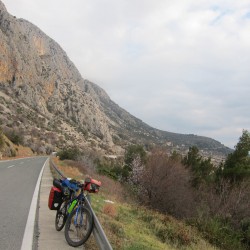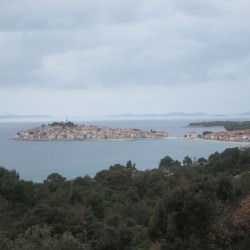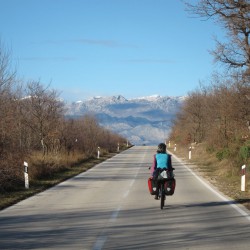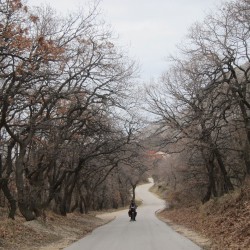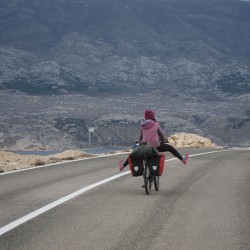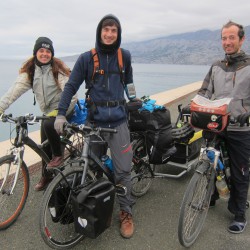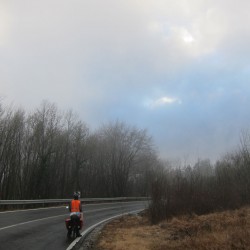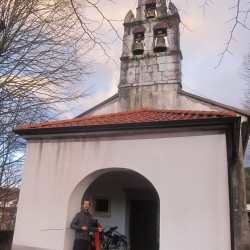After entering Europe, countries definitely became smaller and immigration procedures easier. Since we basically followed the Adriatic sea all the way, I decided to group these countries together into this article.
Albania
Since cycling in Turkey, I was looking forward to reach Albania. Not only because I wanted to cycle here, but mostly for one reason: A long rest. Since leaving Isfahan three months prior, we’ve been chasing visa deadlines and were in need for staying somewhere, where our days were not limited. Albania was perfect: It’s by far one of the cheapest countries to live in of Europe, gives us both generous 90 days and has a mild climate in the winter months.
No surprise then, as soon as we crossed the border, we were aiming for the city of Sarande. We camped in an abandoned building just before the city to give us one full day of apartment hunting as we planned to stay over two weeks. Much frustration followed as it was hard to find places that in name existed on the internet, but in reality not much so! Eventually, I did manage to find a nice place for EUR10 per night with a view on the ocean and a full kitchen. The WiFi only worked on day 2, hot showers were limited to sunny days due to solar water heating and there was no heater, but neither bothered us too much.
- Our temporary home
- Yuilys work desk
- Not a bad location
- Sunset
We started working hard to update our blog, which fell out of care the past months. It was also a good choice to stay here and not further as it started pouring with rain the next days and was never really good weather, so we definitely appreciated a dry place. We definitely enjoyed staying here, as Albanians are definitely a friendly bunch where you get treated with a smile wherever you go. We timed our stay to 17 nights, which would give ourselves exactly two months to reach my hometown in Germany. So, on February 9, 2017, we packed the bikes once more and set our course north. We definitely noticed the days getting warmer, so it was good to wait.
This was a harsh re-introduction to cycling though. The coast road on the Albanian riviera was always rising and falling steeply, with me spinning along in my lowest gears much of the time. At one point, it climbed to above 1000 m only to drop down again! Even though the asphalt was good and the scenery great, we only averaged 40 km per day to Vlore. There, we were hosted by a couple owning a cake shop, which made for a nice slice of birthday cake for Yuily.
- Working
- Camping in olive plantations
- Bunkers of Albania
- Climbing 1000 m…
After Vlore, we had some easier, flatter, more boring days on the way north. It was great not having to feel poor, as we could safely eat out at restaurants and it would cost a few euro at most. In Durres, our host showed us a great Italian food stall, selling homemade pasta dishes for ALL280 (about EUR2), which made Yuily a happy customer. In Shkoder, we had a pizza once more, knowing it was the last time we could afford to dine out in a while.
- Happy Birthday Yuily
- Cheap homemade pasta
- Albanian scarecrow?
- Cheap food!
All in all, I enjoyed Albania. Its long isolation during the communist time makes it one of the strangest and most different countries in Europe today. Some facets remind me of Central Asia, as there are carts pulled by donkeys on the street, cars honk to say hello, children come running toward the road screaming “Hello!” and many main roads marked on maps being potholed mud strips. It’s part of what makes this country so charming. The smiling locals and cheap living costs make me want to return.
Montenegro
Initially I wasn’t looking that much forward to cycling here. I mean, its a fantastic country with so much to see in so little space, but we’ve done it in a backpacking trip three years ago already. I did need to convince myself that everything is different from a bicycle.
I wouldn’t need to worry. Right after crossing from Albania we noticed that groceries are just as cheap and the people smile just as much. We approached Dobra Voda as it got dark and it was a little too populated for wild camping, but fortunately the first farmer I asked for camping in his yard immediately replied “no problem”. His kids were lovely and respectful, practicing their English with us and inviting us to cook in their garage. Who knew Montenegrins could be so hospitable?
We proceeded to take a look at the old town of Bar, which had pretty cherry blossoms all over the place. A cycle on the narrow coast road followed, pretty harrowing for me as traffic certainly didn’t give us the respect distance as they did in Greece! We saw Sveti Stefan again, a hotel made out of a village entirely on a small island, and it was no less impressive the second time.
- Countries pass quick in Europe
- Bar old town
- Sveti Stefan
- Budva old town
Bad weather rolled in and we just made it to Budva as a massive thunderstorm rolled over the town. I convinced Yuily to book ourselves into a guesthouse, as it was going to rain the whole night. This was likely also the last time we could afford it, with EUR12 for both of us.
The rain continued for most of the next day, so we only managed 20 km and, reminiscent of our time in Iran, managed to stay in a mosque. Plowing on, we paid a brief visit to the Bay of Kotor, a magnificent sight. We already visited the town a couple of years ago, so we took the quick ferry across and cycled on into Croatia.
- Mosque
- Bay of Kotor
- Bay of Kotor
- Taking the ferry
Montenegro is such a small country coming packed with beautiful landscapes and villages. It really has to be seen to be believed, and we haven’t even visited the interior yet! People are warm and friendly, the Euro is currency, everything is very affordable… really, there is no reason not to go to Montenegro.
Croatia and a little bit of Bosnia and Herzegovina
This country has more coastline on the Adriatic sea than all the others combined, so we knew we would spend quite a bit of time here. It’s also by far the most tourist-dependent country of Europe, with tourism making up over 40 percent of their GDP. Thus, we already prepared ourselves for not so much generosity.
More cities that we visited before already were on our way, but Dubrovnik was really something we liked to see twice. Just before entering the city, another cycle tourist passed us, and interestingly we knew him: It was Ryan, from Taiwan, who we met in Iran and Turkey as well. He was going to stay in a hostel in town though, while we went to camp.I found a piece of old road to camp on, beautifully overlooking the city, when Yuily suddenly got stopped by a tourist: “I know you! From the internet, I follow your page!” What a nice surprise, we didn’t really expect to bump into followers here.
- As I said…
- Cyclist encounter: Taiwan
- Fan encounter!
- Prime camp spot
- Dubrovnik
- Dubrovnik
- A film set in the old town
- Standing on this rock is good luck
We pressed on further north along the very busy coastal highway. Croatia was by far the most modern country we visited yet, but cycling infrastructure was simply non-existent. Supermarket prices were also really high, most of any country so far, roughly twice the price compared to Montenegro. I wondered how average Croatians are able to afford life.
Therefore, we stocked up well in a cheap bakery in the town of Neum, belonging to Bosnia and Herzegovina, in what is one of the many territorial anomalies of ex-Yugoslavia. Two borders within 10 km, EU and non-EU, and customs officers that have 99% of their business with the transit traffic of the Croatian exclave.
In Ploce, we had some of the most amazing hospitality of the entire trip: Our Couchsurfing host Mijo let us stay in his flat even though he never met us and wasn’t at home for the night, checked on us with messages and just told us to be comfortable. The next morning, he took an early lunch break from work just to meet us, cook us some fish and give us smiles and good luck for on the road before zooming off again to work. It was so pure and unconditional, so genuinely kind-hearted, it made us incredibly happy. We would’ve loved to stay longer, but we wanted to use the good weather.
- Tall cyclist encounter: Spain
- Taking side roads
- Mijo!!!
- Pretty coast road
Croatia and a little bit of Slovenia
Two more days of riding with nice tailwinds saw us get to Split, where we couchsurfed at a student flat just as it started to rain. We spent a few days there to wait out the weather, having a fun time with the Bosnian-Italian-German cultural mix in the flat. We didn’t actually go out much, but that was because we had seen Split before as well.
The whole coastline was incredibly scenic – no wonder it’s such a popular tourist destination. It seemed to me that almost every third house had rooms for rent, advertising them with a sign. The area is so dependent on tourists, it’s really the only thing driving the local economy. Apart from our amazing experience with Mijo, the encounters I had with Croatian people were brief, cold and with little to no personal connection. I don’t really mind being left alone, but here people treated us with such a sheer indifference, I really wondered what’s wrong, I never experienced this on the entire trip. Not even once did I notice someone give us a friendly wave or smile as we rode past…
- Cyclist encounter: South Korea
- Hosts in Split
- Primosten
- Sibenik old town
- War memorial
- School students during Karneval
- Zadar sea organ
- Riding on
We had the chance to visit at least one island out there: Pag, just north of Zadar, has been recommended to us, being connected by a bridge on one and a ferry on the other end. And was it worth it: Just a few km off the coast, the landscape of this island was completely different, as it was composed of mostly compressed sandstone. Apart from some shrubs and one forest, it looked like a yellow moonscape in a special kind of way. Taking back the ferry to the mainland I saw the contrast, as the wasteland of Pag was mere kilometers away from the lush green coast.
- Small forest in Pag
- Desert
- Riding toward the ferry, mainland in the back
- Cyclist encounter: France
Spinning the pedals through some surprisingly sparsely populated regions saw us arrive in Rijeka in a few days. Our luck with the weather so far ran out here, as rain was incoming. I tried to find a roof for us to camp under, but no luck. The usual Croatian indifference played a part as no one showed even a little bit sympathy to help us out, so we eventually camped in the rain.
It didn’t stop in the morning and so we packed a soggy tent and sleeping bags, just with the aim of getting to Slovenia, a new country with hopefully less indifferent people. And, like by some kind of magic, the clouds disappeared once we crossed the border and the sun came out. I tried our luck in the first village right away, and yes! People actually cared and directed us to a roofed area of the local church where we could camp. Two kids would later hand us a hot bottle of tea. We only had about 30 km to cycle in this country before crossing to Italy, but little acts of kindness like this gave us a good impression.
- Rijeka
- Miserable conditions
- In Slovenia, much better
- Camping at the church
I don’t want to make Croatian people seem too bad here. I’m sure we were just not lucky in many situations, as there are amazingly kind Croatians out there as Mijo. As I later learned, there is a certain reservedness in the people stemming from the recent wars, and given what happened back then, they have some very good reasons to be vary of strangers.
I still enjoyed our time on the Adriatic Sea a lot. It’s a beautiful stretch of coastline and the Croatian roads are excellent. We got to camp in some great locations and were lucky with most of the weather. With the Slovenian entry stamp now, Yuily’s 90 days in the Schengen Area started to tick…
Previous: Greece
